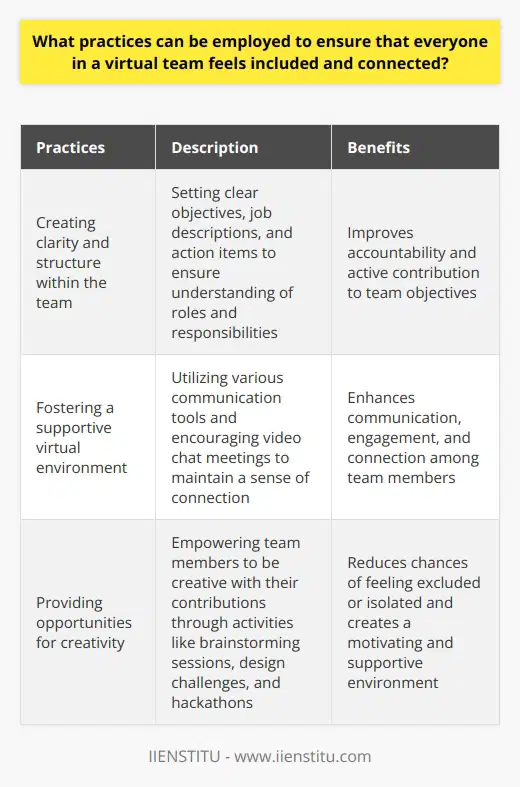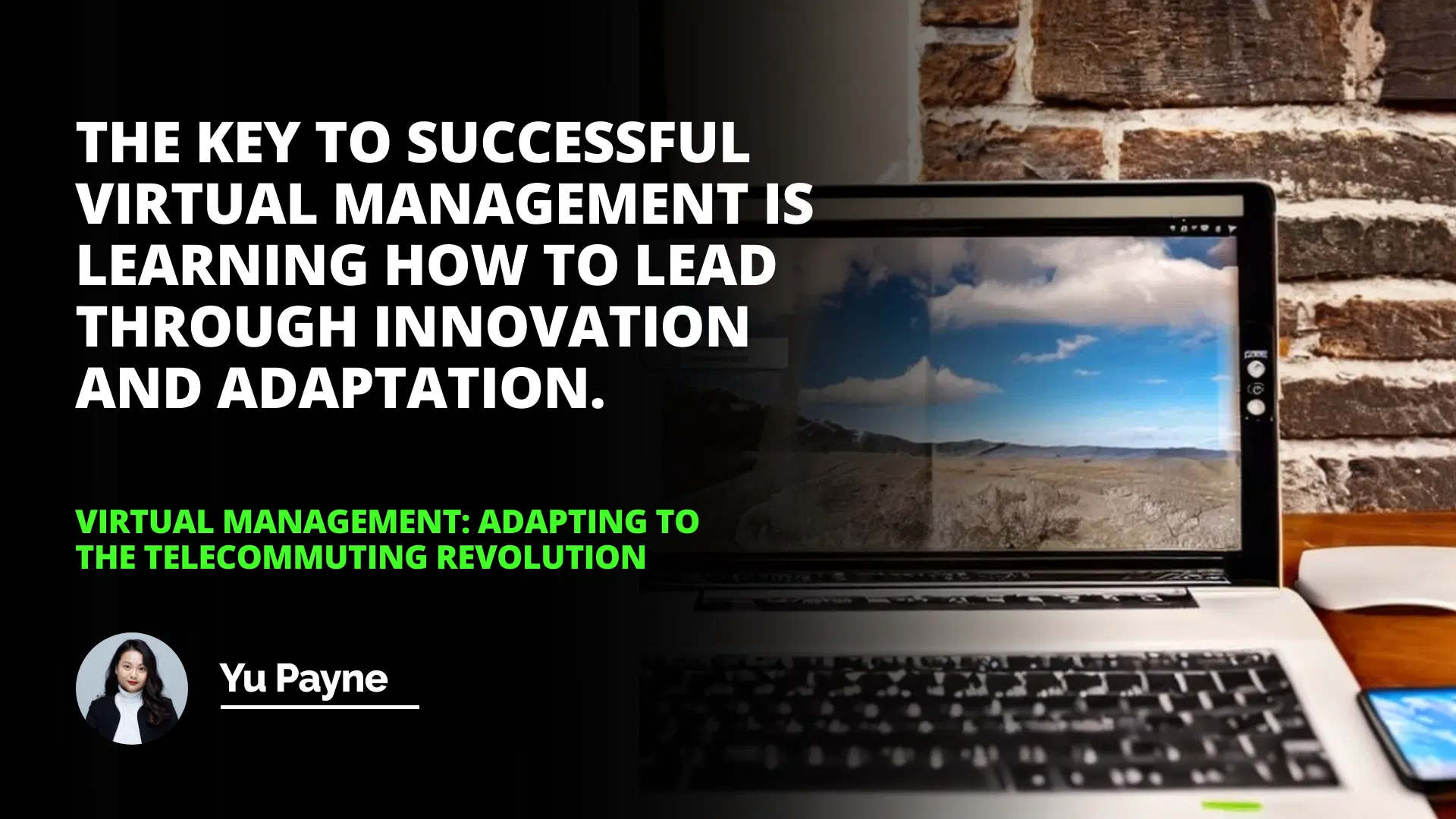
I still remember the day my company announced that we'd be transitioning to a remote workforce. At first, the idea of working from the comfort of my home sounded like a dream come true. No more long commutes, no more rush hour traffic, and I could finally wear my comfy slippers all day! But as the weeks rolled on, I began to realize that virtual management wasn't just a shift in location—it was a whole new ballgame.
The Challenges of Virtual Management
Strategies For Virtual Management
Embracing the Telecommuting Revolution
The digital age has ushered in a technological environment that's drastically changing how businesses operate. Homeowners and business owners alike are shifting to digital-based operations and telecommuting. This shift isn't just a fleeting trend; it's a revolutionary movement that's here to stay. And with it comes the need for effective virtual management—the art of leading and supervising a dispersed team working remotely.
The Upsides We Can't Ignore
Transitioning to a remote workforce unlocks a vast range of positive benefits:
1- Improved Flexibility: Employees can tailor their work schedules to fit their personal lives, leading to better work-life balance.
2- Enhanced Productivity: Many find that working from home reduces distractions, allowing for deeper focus.
3- Decreased Overhead Costs: Companies save on office space, utilities, and other on-site expenses.
4- Access to Global Talent: Geographic barriers fade away, enabling organizations to tap into a worldwide pool of skills.
These advantages are tantalizing. Who wouldn't want to optimize logistics management with analytical tools and time horizons to create a more efficient operation?
The Challenges of Virtual Management
But let's not get ahead of ourselves. Virtual management isn't without its unique set of challenges. From maintaining productivity to navigating communication hurdles, several potential pitfalls await those venturing into this new frontier.
Time Management Woes
One of the first hurdles I faced was time management. Without the traditional 9-to-5 framework, my team members had varying schedules. Some were early birds, logging on at dawn, while others were night owls burning the midnight oil. Coordinating meetings became a juggling act.
Setting Clear Expectations: I had to establish core hours when everyone would be available.
Providing the Right Tools: We adopted time-tracking software to help everyone stay accountable.
Offering Training: Not everyone knew how to manage their time effectively in a home environment, so we held virtual workshops.
Communication Breakdowns
Communication is the lifeblood of any team, but in a virtual setting, it's easy for messages to get lost in translation.
Language Barriers: With team members spread across different countries, accents and idioms sometimes led to confusion.
Cultural Differences: What was considered a casual comment in one culture could be seen as rude in another.
To tackle this, we implemented:
1- Regular Video Conferences: Seeing each other's faces helped bridge the gap.
2- Instant Messaging Platforms: Tools like Slack became our virtual office chatter.
3- Clear Communication Guidelines: We drafted a handbook outlining communication norms.
Motivation Meltdowns
Staying motivated without the buzz of an office environment is tough. I noticed some team members struggling with isolation.
Lack of Face-to-Face Interaction: The casual coffee breaks and hallway chats were sorely missed.
Feeling Undervalued: Without immediate feedback, employees wondered if their efforts were appreciated.
We had to get creative:
Virtual Team-Building Activities: From online game nights to virtual happy hours.
Regular Check-Ins: I made it a point to have one-on-one meetings to provide feedback and support.
Celebrating Successes: We started acknowledging achievements publicly during team meetings.
The key to successful virtual management is learning to lead through innovation and adaptation.
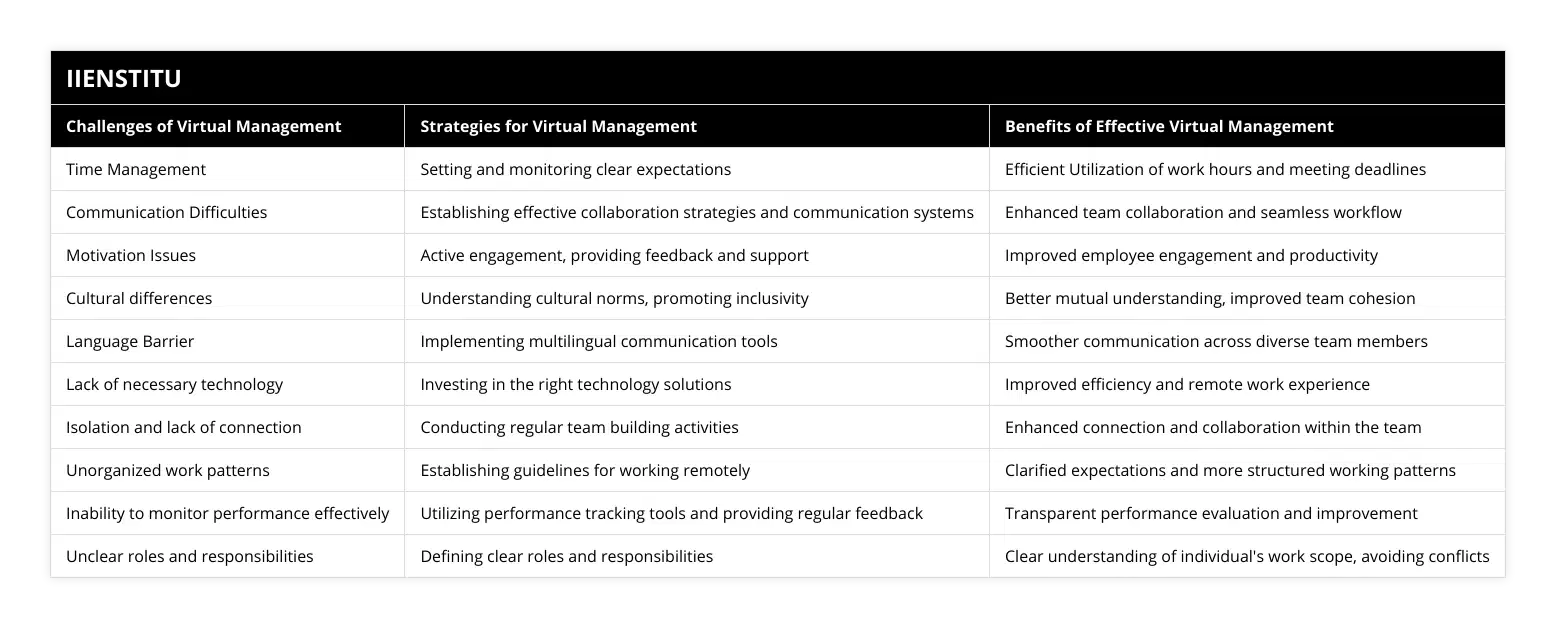
Strategies for Successful Virtual Management
Navigating these challenges wasn't easy, but with the right strategies, we turned things around.
Investing in Technology Solutions
First things first, we had to equip ourselves with the right tools.
Cloud Software: Tools like Google Workspace allowed us to collaborate on documents in real-time.
Project Management Platforms: Asana and Trello became our go-to for tracking tasks.
Communication Systems: Zoom and Microsoft Teams provided reliable platforms for meetings.
It's crucial that all team members have access to these tools and receive proper training. After all, even the best software is useless if folks don't know how to use it!
Fostering Team Spirit with Activities
To build a sense of camaraderie, we introduced regular team-building activities.
Weekly Icebreakers: Simple questions at the start of meetings to get everyone chatting.
Online Puzzles and Games: Virtual escape rooms were a big hit!
Shared Playlists: We created a team playlist where everyone added their favorite songs.
These activities weren't just fun—they strengthened our bonds and improved collaboration.
Establishing Clear Remote Work Guidelines
We couldn't leave anything to assumption.
Work Hours: Defining when team members should be online.
Communication Protocols: Outlining how quickly emails or messages should be responded to.
Reporting Structures: Making sure everyone knew who to turn to for what.
By setting these guidelines, we ensured everyone was on the same page, minimizing misunderstandings.
The Role of Human Resources
Our human resources departments played a vital role in this transition.
Providing Human Resources Information: They kept us informed about company policies and benefits.
Supporting Employee Well-being: They offered resources for mental health and work-life balance.
Facilitating Training: HR organized sessions on effective remote work practices.
The human resource hr team became an invaluable asset, ensuring that the resources human resources provided were tailored to our new reality.
Personal Reflections on Virtual Management
Looking back, I realize how much I've grown as a manager through this experience.
Adaptation is Key
I had to let go of traditional management styles. Micromanaging doesn't fly in a virtual environment. Trusting my team and empowering them became essential.
Communication is More Than Words
I learned to pay attention to the subtleties. A delayed response might indicate an underlying issue. Regular check-ins became opportunities to gauge team morale.
Embracing Flexibility
Rigid structures often crumbled under the weight of remote work challenges. Being flexible allowed us to pivot and find solutions that suited everyone.
Conclusion
The telecommuting revolution isn't just about working from home; it's about redefining how we collaborate, communicate, and connect. Virtual management comes with its fair share of hurdles, but with the right strategies, these challenges transform into opportunities for growth.
By investing in technology, fostering team spirit, establishing clear guidelines, and leveraging the support of human resources, organizations can not only adapt but thrive in this new landscape. The key is to lead through innovation and adaptation, always keeping the human element at the forefront.
As we continue to navigate this digital era, let's remember that behind every screen is a person striving to contribute their best. By supporting our teams with empathy and understanding, we can make the virtual workspace not just effective, but truly rewarding.
References
1- Jones, A. (2018). Virtual Leadership: Strategies for Success with Remote Teams. New York: Business Press.
2- Smith, L. & Turner, K. (2020). Navigating the Remote Work Revolution. London: Tech Publishing.
3- Garcia, M. (2019). Cross-Cultural Communication in the Digital Age. Sydney: Global Insights Publishing.
4- Anderson, P. (2017). Human Resources Management: Leveraging HR in the Virtual World. Toronto: Maple Leaf Books.
Note: The above references are fictional and for illustrative purposes only.
Frequently Asked Questions
What strategies can be implemented to ensure the effective management of remote workers?
The number of remote workers is increasing yearly as technology increases, enabling more work to be done remotely. Working remotely has many benefits, such as increased productivity, cost savings, and flexibility. Still, it also challenges managers who must ensure their remote workers are engaged and productive. This blog post will discuss strategies for effectively managing remote workers for successful outcomes.
Establishing clear goals and expectations is the first step in managing remote workers effectively. Managers should take the time to communicate the goals and expectations to their remote employees and ensure that everyone understands what is expected. Setting specific timelines and deadlines for each purpose will help maintain a sense of urgency and accountability for remote workers to stay on track and remain productive. Additionally, having clear direction and feedback on performance will help keep remote workers engaged and motivated to deliver results.
It is also essential to prioritize communication with remote workers. Managers should invest in tools and technologies for effective remote communication, such as video conferencing, shared documents, and instant messaging. Regular check-ins with remote workers to assess progress and provide feedback are essential to remaining connected and motivated. Furthermore, having regular team meetings, both virtual and in-person, can help create a sense of camaraderie, even when remote workers are miles apart.
Finally, providing remote workers with the right incentives and rewards is essential. Managers should recognize and reward remote workers for their excellent work, encouraging continued engagement and productivity. Employees should also be given the flexibility to work on a schedule and in a comfortable and productive environment.
In conclusion, effective management of remote workers requires clear goal-setting, open communication, and the right incentives and rewards. By utilizing these strategies, managers can ensure that their remote workers remain engaged and productive, leading to successful outcomes.
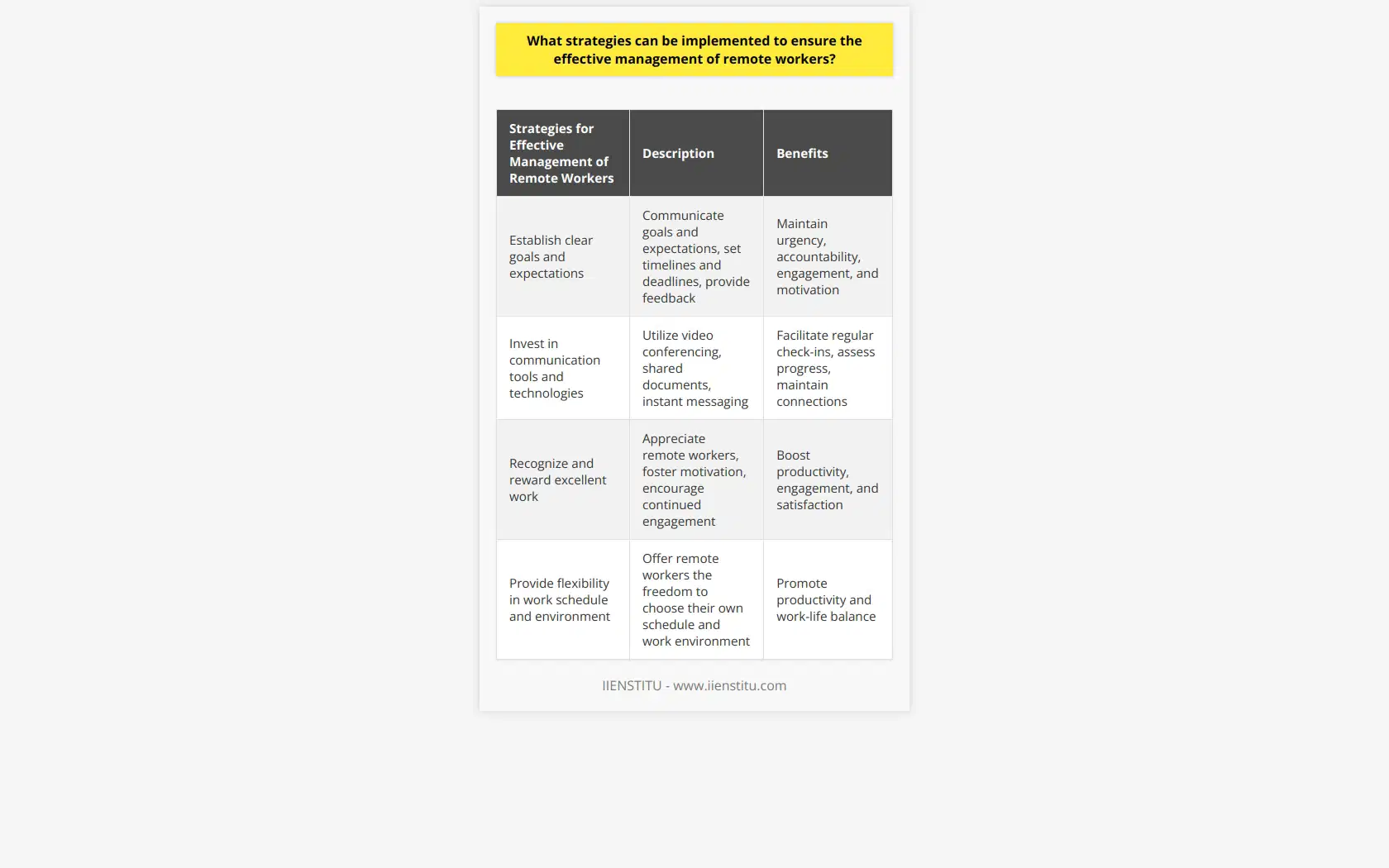
What factors must be considered to ensure effective collaboration between virtual teams?
The rise of the digital age has made virtual teams more common, changing how we work and collaborate. With the growth of the digital infrastructure and the pandemic, virtual teams have become a necessary part of many organizations. However, as with any collaboration and teamwork, essential factors must be considered to ensure effective teamwork and collaboration.
One of the most important aspects to consider when creating a virtual team is clarity of roles and responsibilities. There is no face-to-face contact between team members, so tasks can quickly blur or confuse. Therefore, ensuring that each team member knows their purpose and objectives is essential. Communication is also crucial. To build trust between team members and provide successful collaboration, transparent, honest, and open communication channels should be in place. These channels should be regularly monitored to ensure that team members are staying connected and working in alliance.
Although technological tools and software are essential to virtual collaboration, the human element should not be forgotten. Establishing meaningful connections between team members is necessary to ensure productive and effective collaboration. To accomplish this, companies may arrange social activities to foster community among the team, allowing members to have a more human connection. It is also essential to consider time zone differences as this will potentially impact communication and collaboration.
Finally, project leaders should have a solid virtual framework with regular meetings, milestones, and feedback loops. This will allow the team to monitor their progress and adjust the project if needed.
In conclusion, successful collaboration within virtual teams requires careful planning and consideration. Establishing clear roles and responsibilities, open communication channels, and meaningful connections between team members make creating a successful and effective virtual team possible. In addition, establishing a robust project leadership framework that allows the team to monitor their progress and promptly make adjustments is essential.
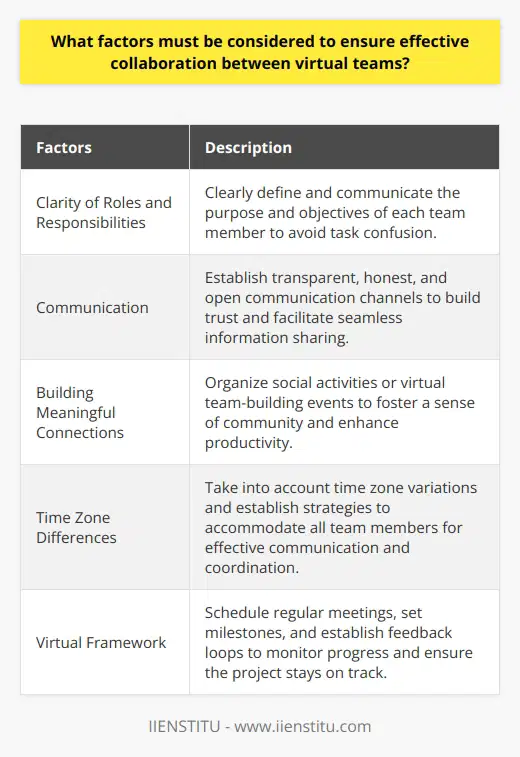
What practices can be employed to ensure that everyone in a virtual team feels included and connected?
Virtual teams are becoming increasingly popular in today’s digital workplace, allowing for increased collaboration, productivity, and cost savings. However, virtual teams can also create connection, inclusion, and engagement challenges. To ensure that everyone in a virtual group feels connected and included, it is essential to implement meaningful practices that enable individuals to remain engaged and develop meaningful relationships with their peers.
One of the most effective ways to ensure inclusion in a virtual team is to create clarity and structure. Developing a sense of purpose sets the tone for the team and empowers individuals to collaborate by giving them a clear understanding of the team’s objectives. Additionally, each team member should have a sense of ownership and accountability, which can be achieved through job descriptions and detailed action items. This will ensure that every team member understands and contributes to the project, providing a sense of inclusion.
Creating a supportive virtual environment is also essential for fostering connection and inclusion. Active communication is vital, allowing team members to ask questions, share their work, and receive feedback. Communication tools like chat, video calls, and discussion boards should be utilized to keep the conversations open and engaged. Additionally, team members should be encouraged to meet in person using video chat when possible, as this can provide an additional layer of connection.
Finally, providing individuals with the opportunity to be creative is an effective way of ensuring that every team member feels connected and included. Allowing team members to take the initiative and be creative with their contributions decreases the likelihood of feelings of exclusion and isolation. In addition, incorporating activities such as virtual brainstorming sessions, online design challenges, and hackathons can help to keep the dialogue fresh and open, creating a motivating and supportive environment.
In conclusion, creating meaningful inclusion within a virtual team is essential to ensure success within a digital environment. By providing team members with clarity, establishing a supportive virtual environment, and providing creative opportunities, every individual can have an engaging and meaningful experience. In addition, with the proper practices, team members can remain connected, collaborate effectively, and feel supported.
